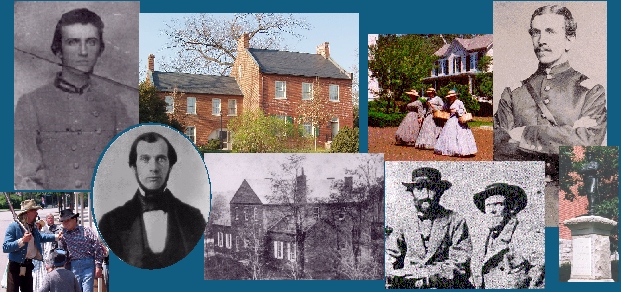

Rockville in 1861 At the outset of the Civil War, Rockville was a country town of 365 residents, just recently incorporated. It was already the seat of Montgomery County. The town's livelihood came from court and government functions, surrounding farming, and a market center at a hub of connecting travel routes. Maryland was a slaveholding border state. Rockville shared in this legacy, having some slave residents and many southern sympathetic citizens, while also having stout Unionists. Whether to secede along with the growing list of Confederate states was debated hotly in formal and impromptu sessions at the courthouse. War Comes to Rockville As war erupted, Rockville saw its sons depart to serve both sides. As an area of uncertain loyalty to the Union cause, astride the major national road between Washington DC and all points west, Rockville, with its cross roads, became strategically significant. During the war, Rockville was visited by armies of both sides. While Union troops occupied the town quickly in 1861 by mounting a Rockville Expedition to secure the western approaches of their capital. They encamped for the duration at the fairgrounds, a provost was appointed and presence of a garrison became a regular wartime sight. Most townspeople sided conceptually with the Confederacy, perhaps finally coaxed that way by Union army occupation. Citizens were summarily arrested on and by both sides, and detained without due process of the law. The Military Effects The major impact of the war was felt as large armies moved through town on campaigns. Here the farming resources of the area felt a heavy hand of foraging (petty theft) and commandeering (sanctioned theft). The loss of horses and stock cut deep into farming livelihoods. During the Antietam Campaign in 1862, the Union army surged through town and returned, drafting the courthouse as a hospital to help treat the staggering number of casualties. During the Gettysburg Campaign in 1863, JEB Stuart brought a big force of Confederate cavalry to town, largely by surprise. Skirmishing gun shots rang out, but badly out-numbered Union forces hastily retreated. Stuart's troops ambushed a major supply wagon train on the Rockville Pike and mostly spent the day bringing-in and re-organizing these captured supplies. Yet, the Confederates (apparently supplied with a handy list) found time to arrest leading Union sympathizers and march them away in their column (they were paroled later). Stuart's troops generally respected private property, having their hands full with captured Federal government supplies and recognizing that badly treating a sympathetic border town was poor policy.
|
More Armies and Fighting in the Streets A whole Confederate army returned to Rockville as Jubal Early advanced on Washington City during his raid in 1864. Fresh from field victories at Winchester and Monocacy, Early was trying to surprise the enemy capital by quick flank attack. Sparse Union cavalry detachments mounted desperate delaying skirmishes at every opportunity down Frederick Road and the Rockville Pike, including stands above, in and below Rockville. After failing to take Fort Stevens and enter Washington, Early's army returned on his retreat. Here a large rearguard cavalry action ranged on the streets of town, termed the Battle of Rockville. Young men on both sides killed and died along Darnestown Road and Commerce Lane (Montgomery Avenue today), Courthouse Square, the Rockville Pike and side streets. Meanwhile, Early's army made good its escape across the Potomac fords. The courthouse again became a military hospital, this time treating local casualties. Union forces reoccupied the town and were not challenged again. On the Home Front As important as military aspects in wartime, are the stories of Rockville residents. Divided loyalties did not make an entirely divided community. The people seemed to appreciate that this war would pass and they meant to continue to live together. This is best shown by citizens confronting officers of whichever army was arresting civilians and arguing for release of their neighbors, at some hazard of self-incrimination. After the war, most of the community returned to life as usual. This may be seen as marriages occurred between families across the wartime divisions. A significant change did occur for former slave residents and the enterprises that relied on their labor. Many freed slaves stayed in the community, building new lives and homes and mixing with the existing pre-war free black population. In the end, the southern sympathetic but uncertain reputation of the town may have served it well from the worst hardships that hardened armies could visit upon it. Neither side wished to push the town any closer to the other side and therefore sought to avoid offending, unless for dire military objective. The town did mourn its losses but quickly set aside animosity to return to the shared objectives of daily living.
|
Map of Rockville in the Civil War
Timeline of Rockville in the Civil War
| Being There | Looking Back |
|
The Major Events
Everyday Life About Town
|
What happened
We Commemorate
About Town
|
Links to Other Civil War History On-Line Resources
© 2006, Peerless Rockville, Historic Preservation Ltd.